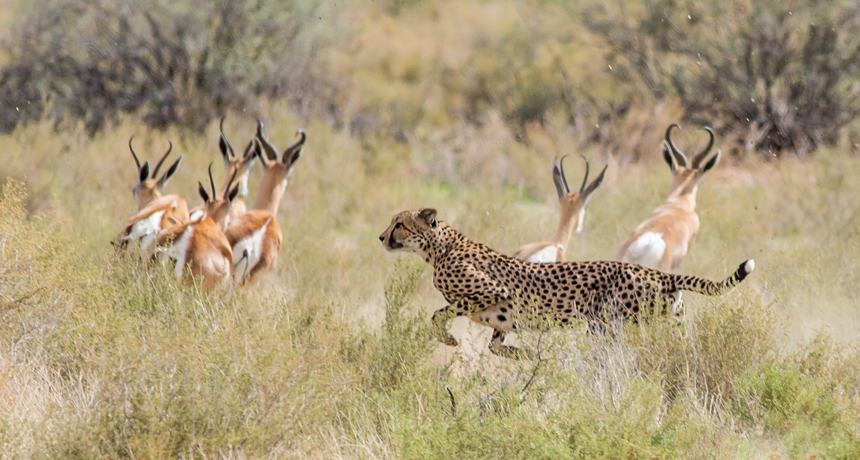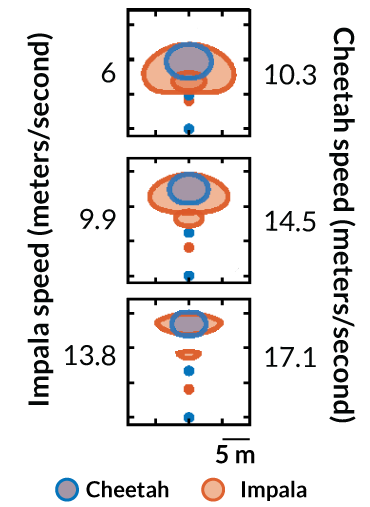
FAST CATS Big cats like this cheetah may be more athletic than their prey, but life-and-death chases are about more than speed. Sharp turns may give prey their best chance at escape.
Antero Topp/shutterstock
First, a note to any impala suddenly rushed by a cheetah: Do not — repeat, do not — just zoom straight off as fast as four hooves can carry you.
The best escape move, according to analysis of the most detailed chase data yet from big cat predators, is some fluky turn, even though turning requires a slower stride. Swerve far enough, and the cheetah will be racing too fast to make the same turn.
Overall, cheetahs and lions are more athletic than the impalas and zebras they chase, but prey still have a chance, says Alan Wilson of the Royal Veterinary College of the University of London in Hatfield. He and his colleagues worked with researchers in Botswana to collect abundant motion data — several hundred thousand strides’ worth — from wild animals and reconstruct their sprints and turns. “You’re actually doing a step-by-step dissection,” Wilson says, “which is pretty cool.”
Wilson, a veterinarian and research scientist who describes himself as “an equipment geek,” began collecting data in 2011 on cheetah chases (SN: 7/13/2013, p. 9). “Typically your tracking collar will tell you where an animal is once an hour, or once every five minutes if you’re lucky,” he says. Wilson and his colleagues designed collars that record data for calculating position, speed and acceleration multiple times a second. The collar falls off animals after a certain time so that researchers can retrieve it and download data on the animals’ adventures.
Wilson’s team collected collar data for two predator-prey groups in Botswana’s savannah — cheetahs and impalas, and lions and zebras — though none of the collared cats were recorded chasing the collared prey. Comparing the information from more than 5,500 running episodes, the team found that each predator could outdo its typical prey by about 38 percent in speed. The predators also had about 37 percent greater acceleration and 72 percent better deceleration. Wilson and his colleagues also nipped tiny samples of muscle fiber and carried them in liquid nitrogen to England to measure muscle contraction power. Both predators had about 20 percent more fiber power in a leg muscle than the prey.
To see how an impala or zebra might escape such formidable hunters, the researchers created stride-by-stride computer simulations of hypothetical pursuits. At top speeds, prey had few options for veering to where a predator couldn’t pounce. The best hope for prey came at slower speeds, when they could pivot more to the side. Lending credence to these computer results, the actual collar records showed a lot of running at merely moderate speeds by both predator and prey.
Putting numbers on the athletic powers of wild predators and prey “enables you to understand the ecosystem” Wilson says. “Your prey has to be fast enough to escape some of the time, but not all of the time. If you took lions and put them on a tropical island covered in sheep, they’d eat all the sheep — and then there’d be no lions.”
The detailed collar data allowed for an unprecedented level of analysis, says biomechanist Paolo Domenici, of the Institute for Coastal Marine Environment’s center near Oristano, Italy. Five or 10 years ago, he notes, measurements of animal athletics came mostly from treadmills or other laboratory setups without a sense of what real-world emergency might prompt particular motions.
This study “definitely adds a major piece of the puzzle in the predator-prey arms races,” Domenici says. Now “it would be interesting to test predator-prey systems in other environments to see if predators show consistently higher performance than their prey.”
But predators hunt in many more ways than pursuit, says comparative biomechanist Talia Moore of the University of Michigan in Ann Arbor, who has studied the unpredictable escape hops of little desert rodents called jerboas. She hopes the detailed look in the new paper will inspire more analysis of the diversity of predation, including animals that hunt by ambush.







